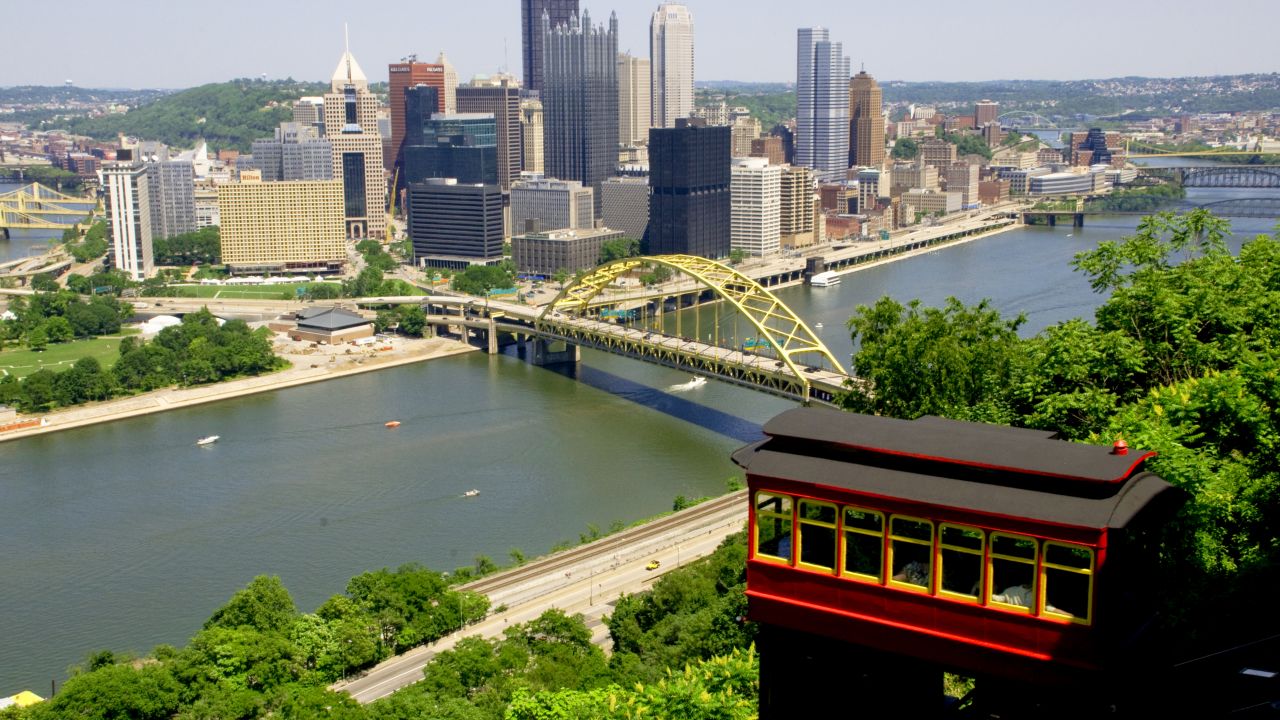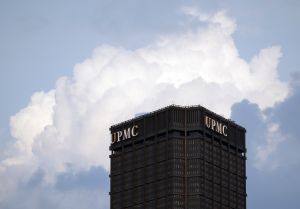
Pittsburgh's downtown is a reflection of the city's resilience. (Photo by Education Images/UIG via Getty Images)
EDITOR’S NOTE: As many experts have observed, this year’s presidential election could come down to a battle for votes Democrats used to take for granted.
Donald Trump is making an overt play for the so-called “Reagan Democrats,” blue collar voters whose defection three decades ago shook up the national political landscape and stoked the Reagan revolution. It’s no accident that Hillary Clinton’s first post-convention foray was into once reliably Democratic steel and coal country. Now, as then, the issues facing these voters are job and income security in a changing world. Only now, those concerns are being felt by far more than the steelworkers and their families whom Ronald Reagan wooed in 1980.
America’s deindustrialized heartland embodies one of the challenges reshaping the nation’s politics: The disappearance of the middle class and the growing gap between the haves and have-nots. That’s why BillMoyers.com is paying particular attention to these communities this year, focusing on their issues and giving voice to the people who live there. You can read more of our collection here.)
When the Democratic presidential ticket’s post-convention Rust Belt tour arrives in Pittsburgh on Saturday, Hillary Clinton and Tim Kaine may at first wonder where the rust is.
The pair will hold a rally in the city’s downtown convention center, a modernistic swoosh of a building that is certified “green.” It graces a glittering urban riverfront where once-sooty steel mills have been replaced by amenities like fountains and bike trails. The city’s tallest skyscraper, built as the headquarters of U.S. Steel Corp., now bears the logo UPMC: University of Pittsburgh Medical Center, a leader in the “eds and meds” economy that’s driving Pittsburgh’s latest renaissance.

The corporate headquarters of the US Steel Corp. now bears the logo of health care giant UPMC, symbolizing the transformation of Pittsburgh’s economy. (Photo by Justin K. Aller/Getty Images)
That’s the good news. And, in a way, the bad news.
Few, if any, cities better illustrate the reasons for the economic anxiety that Clinton and Kaine will confront as they travel across Pennsylvania and Ohio, or so perfectly encapsulate the increasingly yawning gap that divides the spectrum of voters Clinton says she wants to attract: “the struggling, the striving and the successful.”
To understand that is to understand why Ed Rendell — a former Pennsylvania governor, former chairman of the Democratic National Committee and a longtime Clinton ally — thinks Donald Trump could win his state in November.
In some respects, Pittsburgh has made a remarkable comeback since the 1980s, when the metropolitan area lost half of its manufacturing jobs as the steel industry retrenched. At one point, the unemployment rate topped 15 percent and the area was losing 50,000 people a year, most of them young.
“By the ’90s people had decided we had died,” says Pittsburgh Mayor Bill Peduto. “I think in some ways we had started to figure out how to manage decline.”

Bill Peduto, mayor of Pittsburgh, was elected in 2013. (Photo: Patrick T. Fallon/Bloomberg via Getty Images)
Today, Peduto, who describes himself as a progressive Democrat, has to figure out how to manage a very different kind of problem.
Over the past decade, attracted largely by Carnegie Mellon University, a school that has done cutting-edge work in robotics, high-tech companies like Google and Uber have established major presences in Pittsburgh. That’s turned formerly sleepy, even blighted, areas of town into hotbeds of gentrification.
“There are new shops being built, where people who have lived in the neighborhood for 50 years walk by and say, ‘I can’t afford to shop there,’” Peduto says. “New hotels going up which they see and say, ‘Nobody in my family will ever stay there.’ And apartments being built which they see and say, ‘I’ll never be able to afford to live there and this is my neighborhood.’ That’s real. That’s not perceived, that’s real.”
Worse, because “people are moving back to cities at a very fast rate,” Peduto says, housing has become less affordable. That’s a problem because “the most basic services our most vulnerable population need are located in a city.”
— Pittsburgh Mayor Bill Peduto
“The transportation networks, especially public transportation, are built around a city,” the mayor continues. As distance and transportation costs mount, it becomes harder to get to a job, see a doctor, get to a class. It all adds up to “creating a situation where there is no opportunity to succeed.”
But when asked about the source of the anger and resentment that Trump has tapped in his campaign, Peduto doesn’t trace it to the vulnerable population that’s being pushed out of the city’s rapidly improving neighborhoods. Instead, he sees it in the intransigence of better-off taxpayers who don’t want to provide the housing, transportation and education subsidies that might help their neighbors succeed.
“People are looking at the person next to them’s plate and seeing what’s on it and not looking down at their own plate and seeing what they have,” he says. “A public transit system is pennies to the dollar what a highway system is. When you design a city and you build massive bridges and then tunnels and then highways and people move further out from the city, they’re basically building a driveway for them to leave the city, which comes at a cost of tens of billions of dollars — compared to maybe a $100 million subsidy to build a bus service so somebody can get to their doctor.
“But because there’s $100 million being spent, people will point to that,” Peduto adds. “Because they won’t use a bus. Because they have three cars. And they’ll say, ‘Why are we spending money there?’”
Though they still come together to root for their sports teams — the Pirates, the Penguins and the now-anachronistically named Steelers — politically and economically, Pittsburghers seem to be pulling apart. In 1980, western Pennsylvania’s congressional delegation was homogeneously Democratic. Today, the city proper is represented by Democratic Rep. Mike Doyle, but the surrounding suburbs are all represented in the US House by Republicans — most of whom have announced they are backing Trump.
Part of the reason may be the widening economic divide. In 1970, the median income was more than $7,500 (more than $45,000 adjusted to 2014 dollars) in the iconic steel towns of Braddock and Homestead, just downriver from Pittsburgh. In Fox Chapel, a plush bedroom community, the median income was more than four times higher, at more than $31,000. Today, however, the gap is much wider. Fox Chapel’s median in 2014 was $168,000 (more than $189,000 in inflation-adjusted dollars).
While the affluent incomes of Fox Chapel may not have kept up with inflation, the steel towns that aren’t quite visible from Pittsburgh’s downtown have done substantially worse. In Braddock and Homestead, incomes hover in the mid-$20,000s, meaning their better-off Fox Chapel neighbors make seven times more than they do.
A big reason is the change in the types of jobs available. In Homestead, on the site once occupied by the world’s largest steel mill, is now The Waterfront, a playground of stores, movie theaters and restaurants. The owners kept some of the Homestead Works brick smokestacks and now use them as a landmark and a logo.
— Pittsburgh Mayor Bill Peduto
Back in the 1980s, when the Homestead Works shuttered, Peduto was a young operative working on other politicians’ campaigns. Like Trump now, “everyone had a plan for how they were going to bring the mills back,” he says. He scoffs at the idea of that happening. But he does think that Homestead, where the labor movement was birthed in an historic strike at the end of the 19th century, has some lessons for today’s economy.
While Pittsburgh’s tech workers may be doing well enough to drive the cost of city housing through the roof, “the service industries are very much in the same position right now as the mills and mines were in the 1880s,” Peduto says. “You see hospital workers who make $11 an hour who have worked there for 20 years. The ability for them to break cycles of poverty doesn’t exist.” Similarly, people who work in retail, “especially big-box stores,” he adds, “are placed on a wage that requires them to get public subsidies for housing, public subsidies for transportation, public subsidies for food.” That, Peduto says, amounts to a taxpayer subsidy of the corporations that own those stores.
“You’ve seen a shift from industry to service but you haven’t seen a shift in the benefits,” Peduto says. “In cities like Pittsburgh and Detroit and Cleveland, we were able to build a middle class out of an industrial revolution, even though it took decades to do so.”
Peduto himself is a beneficiary: His grandfather, who went to work in a steel mill with a second-grade education, was in many ways better off than today’s service industry employee, who “doesn’t have the same opportunity to buy a home, to get his kids into college,” the mayor says.
That’s why Peduto has ordered the minimum wage for city workers hiked (gradually) to $15 an hour. He says he helped to nudge UPMC to do the same, and is now trying to convince the city council to mandate that all city contractors offer a $15-an-hour minimum wage. Meanwhile, Peduto says he is convinced education is the key to unlocking the doors of the middle class for young people. He says the city this fall will sponsor a “rec to tech” program that turns some of the city’s parks into education centers.
Peduto says he’s optimistic because he sees cities as the laboratories as the future and himself as part of “a progressive wave of mayors” that began getting elected in cities across the country in 2013.
“If you want to see where the Bernie wave started, it started back then,” he says.
Will it be enough to overcome the alienation and anger that’s fueling the Trump tsunami? That’s the challenge for Peduto, his fellow Rust Belt Democrats and the Clinton-Kaine ticket between now and Election Day.




